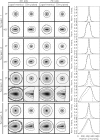Experimental validation of Monte Carlo (MANTIS) simulated x-ray response of columnar CsI scintillator screens
- PMID: 19994503
- PMCID: PMC2773454
- DOI: 10.1118/1.3233683
Experimental validation of Monte Carlo (MANTIS) simulated x-ray response of columnar CsI scintillator screens
Abstract
Purpose: MANTIS is a Monte Carlo code developed for the detailed simulation of columnar CsI scintillator screens in x-ray imaging systems. Validation of this code is needed to provide a reliable and valuable tool for system optimization and accurate reconstructions for a variety of x-ray applications. Whereas previous validation efforts have focused on matching of summary statistics, in this work the authors examine the complete point response function (PRF) of the detector system in addition to relative light output values.
Methods: Relative light output values and high-resolution PRFs have been experimentally measured with a custom setup. A corresponding set of simulated light output values and PRFs have also been produced, where detailed knowledge of the experimental setup and CsI:Tl screen structures are accounted for in the simulations. Four different screens were investigated with different thicknesses, column tilt angles, and substrate types. A quantitative comparison between the experimental and simulated PRFs was performed for four different incidence angles (0 degrees, 15 degrees, 30 degrees, and 45 degrees) and two different x-ray spectra (40 and 70 kVp). The figure of merit (FOM) used measures the normalized differences between the simulated and experimental data averaged over a region of interest.
Results: Experimental relative light output values ranged from 1.456 to 1.650 and were in approximate agreement for aluminum substrates, but poor agreement for graphite substrates. The FOMs for all screen types, incidence angles, and energies ranged from 0.1929 to 0.4775. To put these FOMs in context, the same FOM was computed for 2D symmetric Gaussians fit to the same experimental data. These FOMs ranged from 0.2068 to 0.8029. Our analysis demonstrates that MANTIS reproduces experimental PRFs with higher accuracy than a symmetric 2D Gaussian fit to the experimental data in the majority of cases. Examination of the spatial distribution of differences between the PRFs shows that the main reason for errors between MANTIS and the experimental data is that MANTIS-generated PRFs are sharper than the experimental PRFs.
Conclusions: The experimental validation of MANTIS performed in this study demonstrates that MANTIS is able to reliably predict experimental PRFs, especially for thinner screens, and can reproduce the highly asymmetric shape seen in the experimental data. As a result, optimizations and reconstructions carried out using MANTIS should yield results indicative of actual detector performance. Better characterization of screen properties is necessary to reconcile the simulated light output values with experimental data.
Figures









Similar articles
-
A fast, angle-dependent, analytical model of CsI detector response for optimization of 3D x-ray breast imaging systems.Med Phys. 2010 Jun;37(6):2593-605. doi: 10.1118/1.3397462. Med Phys. 2010. PMID: 20632571 Free PMC article.
-
Light output measurements and computational models of microcolumnar CsI scintillators for x-ray imaging.Med Phys. 2015 Feb;42(2):600-605. doi: 10.1118/1.4905096. Med Phys. 2015. PMID: 28102604
-
Validation of columnar CsI x-ray detector responses obtained with hybridMANTIS, a CPU-GPU Monte Carlo code for coupled x-ray, electron, and optical transport.Med Phys. 2013 Mar;40(3):031907. doi: 10.1118/1.4791642. Med Phys. 2013. PMID: 23464322
-
Anisotropic imaging performance in breast tomosynthesis.Med Phys. 2007 Nov;34(11):4076-91. doi: 10.1118/1.2779943. Med Phys. 2007. PMID: 18074617
-
Anisotropic imaging performance in indirect x-ray imaging detectors.Med Phys. 2006 Aug;33(8):2698-713. doi: 10.1118/1.2208925. Med Phys. 2006. PMID: 16967568
Cited by
-
A comparative analysis of OTF, NPS, and DQE in energy integrating and photon counting digital x-ray detectors.Med Phys. 2010 Dec;37(12):6480-95. doi: 10.1118/1.3505014. Med Phys. 2010. PMID: 21302803 Free PMC article.
-
Development and characterization of a dynamic lesion phantom for the quantitative evaluation of dynamic contrast-enhanced MRI.Med Phys. 2011 Oct;38(10):5601-11. doi: 10.1118/1.3633911. Med Phys. 2011. PMID: 21992378 Free PMC article.
-
Modeling and evaluation of a high-resolution CMOS detector for cone-beam CT of the extremities.Med Phys. 2018 Jan;45(1):114-130. doi: 10.1002/mp.12654. Epub 2017 Nov 27. Med Phys. 2018. PMID: 29095489 Free PMC article.
-
Deriving depth-dependent light escape efficiency and optical Swank factor from measured pulse height spectra of scintillators.Med Phys. 2017 Mar;44(3):847-860. doi: 10.1002/mp.12083. Epub 2017 Feb 13. Med Phys. 2017. PMID: 28039881 Free PMC article.
-
A fast, angle-dependent, analytical model of CsI detector response for optimization of 3D x-ray breast imaging systems.Med Phys. 2010 Jun;37(6):2593-605. doi: 10.1118/1.3397462. Med Phys. 2010. PMID: 20632571 Free PMC article.
References
-
- Jing T., Goodman C. A., Drewery J., Cho G., Hong W. S., Lee H., Kaplan S. N., Mireshghi A., Perez-Mendez V., and Wildermuth D., “Amorphous silicon pixel layers with cesium iodide converters for medical radiography,” IEEE Trans. Nucl. Sci. IETNAE 41(4), 903–909 (1994).10.1109/23.322829 - DOI
-
- Nagarkar V. V., Gupta T. K., Miller S. R., Klugerman Y., Squillante M. R., and Entine G., “Structured CsI(Tl) scintillators for x-ray imaging applications,” IEEE Trans. Nucl. Sci. IETNAE 45(3), 492–496 (1998).10.1109/23.682433 - DOI
Publication types
MeSH terms
Substances
Grants and funding
LinkOut - more resources
Full Text Sources
Medical
Research Materials

